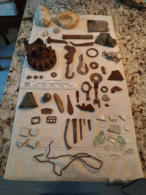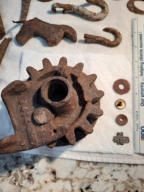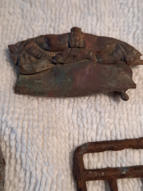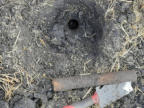

© 2025 Roger Fontaine, Designed by Bison Software

Metalman9
M
E
T
A
L
M
A
N
9


M
E
T
A
L
M
A
N
9


Ph: 204-223-7809
METALMAN9
Ph: 204-223-7809
METALMAN9
Click the date link, then a photo to start larger photo gallery & see descriptions

October 19, 2022 - How About those Bells… and a Wheat Pattern
October 19, 2022
How About those Bells… and a Wheat Pattern.
It
only
took
a
few
minutes
and
a
short
walk
and
4
ironstone
pieces
were
found
and
as
a
bonus,
2
pieces
had
markings,
possibly
identifiable.
This is how October 19, 2022 started on River Lot # 159.
The
river
lot’s
east
end
is
bisected
by
a
gravel
road
that
the
locals
refer
to
as
the
Old
14,
and
by
the
banks
of
the
Red
River.
The
roadway
creates
an
odd
shaped
triangular
piece
of
land
that
tends
to
be
difficult
to
farm
due
to
its
small
size.
Nonetheless,
here
I
am
doing
a
preliminary
walk
through
to
determine
its
potential
having
metal
detecting
in
mind.
The
plan
is
to
return
in
a
few
days
with
a
fellow
detectorist
and
see
what
we
can
find
on
this
otherwise
nondescript, triangle shaped portion of river lot.
There
is
no
record
anywhere
that
I
could
find
to
suggest
that
anyone
ever
lived
on
this
piece
of
property
but
any
sign
of
human
activity could make this a very interesting hunt.
On
a
very
slight
rise,
next
to
where
the
river
bank
starts
its
descent
towards
the
river,
I
found
one
piece
of
white
pottery.
Now
that
was
an
Ah
Ha
moment.
Then
I
spotted
another,
and
then
two
more.
The
ground
here
is
covered
with
wheat
stubble
which
makes
finding
small
artifacts
rather
difficult.
I
saw
no
glass,
I
saw
neither
nails,
nor
any
metal
parts
but
4
pieces
of
ironware
tells
me
that
at
some
point
in
time
someone
was
here
with
some
sort
of
dishware.
They
were
here
long
enough
to
see
this
dishware
get
broken
and
then
discarded.
Being
able
to
positively
identify
the
ironware
gives
us
potential
habitation
dates.
Oh
the
joy
when
history
and
metal
detecting meet.
I
called
on
our
good
friends
Sid
and
Pam
Kroker
to
help
with
the
identification
of
the
ironware
based
on
the
printing
and
on
the
pattern.
Here for your enjoyment was Sid’s reply…
“
The
pieces
are
pretty
small
but
we
can
provide
a
bit
of
information.
They
are
ironstone
which
is
a
utilitarian,
heavy
type
of
porcelain
and
probably
come
from
a
dinner
plate.
The
one
on
the
left
is
the
"wheat"
pattern.
(If
I
recall
correctly,
we
gave
you
a
plate
of
that
type.)
There
are
over
40
different
"wheat"
manufacturers
and
more
than
one
pattern
from
some
of
the
pottery
firms.
From
what
is
visible,
we
aren't
able
to
identify
the
type
of
pattern
or
the
maker.
Most
of
the
pottery
firms
that
produced
the
"wheat"
pattern
were
in
England,
a
couple
in
Scotland,
one
in
Canada,
and
one
in
France.
The
Canadian
company
-
St.
Johns
Stone
Chinaware
Company
of
St.
Johns,
Quebec,
was
in
business
from
1873
to
1899.
The
earliest
patent
for
a
raised
wheat
pattern
was
registered
in
1848
with
some
companies
continuing
production
into
(and
perhaps
beyond)
the
1970s.
I
would
guess
that
your
treasures
probably
date
from the turn of the century (1885 -1915), but that is just a guess.”
“The
partial
mark
on
the
second
is
just
that
-
an
annoying
partial.
Just
enough
of
a
design
to
hint
at
something
which
doesn't
pan
out
when one checks the reference.”
Hope this helps
Sid
The
remainder
of
the
day
was
spent
detecting
the
area
known
as
Two
Little
Points
Farm
(River
Lot
#
153).
Here,
habitation
is
well
documented.
This
location
has
been
a
constant
source
of
new
and
exciting
finds
and
today
was
no
different.
I’ve
learnt
from
other
detectorists
that
a
site
or
a
location
is
never
really
cleaned
out.
There is always something just waiting to be found.
Probably
the
best
finds
of
the
day
were
the
heavy
brass
cow
bell
and
the
horse
collar
/
sleigh
bell,
also
very
heavy.
A
small
partial
Crucifix
speaks
to
the
inhabitants’
history.
A
pocket
knife,
a
purse
clasp,
an
ornate
piece
of
decorative
iron,
a
large
farm
equipment
gear
and
a
small
clock
gear.
Talk
about
extremes.
For
similar
clock
parts
found
on
this
site,
see
October
9,
2020,
picture
#
11
.
Personally,
I
like
the
buckles
and
button.
The
button
says
“J
H
S
Canada.”
And
lots
of
square
nails.
I
just
love
finding
square
nails.
They
speak
to me. They say: “This site is old… Keep looking.”
On
the
geology
side
of
things,
I
found
a
few
interesting
rock
samples.
One
is
the
fossilized
remnants
of
a
shell.
The
cow’s
tooth
is
not
quite
as
old.
And
notice
the
last
picture.
It
is
a
piece
of
Chert
or
more
commonly
called
Flint
that
has
been
completely
encased
in
sedimentary
rock.
How
many
millions
of
years
did
that
process
take? From where did the flint originate?
What a story this rock could tell.
Check
out
the
next
story
on
October
22,
2022
for
a
follow
up
hunt
on River Lot 159.
The little triangle that could.
Sources: Sid and Pam Kroker
The Wheat Pattern by Lynne Sussman
http://parkscanadahistory.com/series/saah/wheatpattern.pdf

















October 22, 2022 - Monty, Myself, and the triangle field of River lot # 159. The little triangle that could.
October 22, 2022
Monty, Myself, and the triangle field of River lot # 159.
The little triangle that could.
The
preliminary
background
to
this
story
can
be
found
in
the
previous
outing
of
October
19,
2022.
The
two
stories
are
interlinked
along
with
the next story which is the afternoon segment.
If
anything
that
metal
detecting
and
watching
others
metal
detect
on
YouTube
has
taught
me,
is
that
patience
and
persistence
play
a
huge
part.
I’ve
also
learnt
that
the
most
mundane
looking
places
can
yield
great
finds.
True
is
the
adage
that
you
cannot
read
a
book
by
its
cover.
Places
that
I
thought
looked
promising
often
were
not.
And
places
that
don’t
look
like
much
or
that
show
minimal
signs
of
human
activity
can
surprise
you.
The
east
end
of
River
Lot
#
159
is
a
good
example
of this.
I
first
met
Monty
this
year
when
we
teamed
up
at
Winnipeg
Beach.
It’s
there
that
we
also
met
Randy.
(See:
September
7,
2022
Monty,
Randy,
Winnipeg
Beach,
and
Me
.)
Randy
showed
me
a
picture
of
a
very
very
old
British
coin
that
he
found
in
an
open
field
in
the
Red
River
Valley.
The
coin
predated
any
settler
by
about
500
years
plus.
It
presumably
was
a
keepsake
from
the
old
country,
lost
on
the
prairie
by
an
early
settler.
The
point
has
been
made
over
and
over
by
this
and
by
similar
other
finds
that
all
you
need
is
for
one
person
to
have
walked
on
the
land
that
I’m
detecting
on
and
they
lose
something…
It’s
not
always
about
old
building
foundations
or
ancient
garbage
dump
sites
or
visible
proof
of
habitation,
although
these
things
help
greatly
in
finding
relics
and
artifacts,
but
that
unexpected
finds
can
come
from
the
most
benign
looking
field.
Yes,
it
helps
that
the
area
detected
is
near
a
reliable
water
source
or
near
population
centers
or
close
to
known
travel
routes
and
luck
also
plays
a
part
but
what
joy
it
is to find these little treasures.
And just what are the odds eh!
Monty
has
a
real
liking
for
the
edges
and
borders
of
fields.
Personally,
I
prefer
an
open
and
plowed
field.
Detecting
and
then
digging
through
tall
grass
and
weeds
is
much
more
difficult
but
they
are
the
areas
where
farmers
and
passer-by
often
discard
unwanted
items.
And
for
the
same
reasons,
they
are
areas
that
are
often
never
detected
thus
one
has
a
better
chance
of
finding
things.
Monty
headed for the weeds and worked the open field.
In
total,
we
collected
30
pounds
of
iron
along
with
a
dozen
or
so
pieces
of
glass
and
pottery
shards
and
a
small
assortment
of
non-
ferrous
metal
items.
One
such
item
looks
a
lot
like
the
top
portion
of
a
horse
collar
bell.
We
found
the
usual
array
of
square
nails
and
even
a
copper
wire.
Clearly
this
little
triangle
of
land
has
seen
a
lot
more
human
activity
and
possible
habitation
than
what
meets
the
eye.
The
location
is
what
I
would
refer
to
as
virgin
territory:
Previously
undetected.
Monty
and
I
both
found
items
most
everywhere
we
swung
the
detector
coil.
Monty
was
even
able
to
match
together
two
pieces
of
rounded
iron
which
he
found
well
apart
from
each
other,
the
function of which I have no idea.
The
bigger
pieces
I
photographed
in
our
garage.
The
remainder,
I
brought
in
and
cleaned
them
up
as
they
are
all
unique
in
shape
and
have
a
variety
of
possible
functions.
One
piece
is
clearly
a
piece
of
a
cast
iron
stove
top.
You
can
see
where
two
of
the
round
cook
lids
fit.
One
piece
has
the
letters
N
A
M
A
stamped
in.
(Panama)?
There’s
part
of
a
door
latch
and
a
turn
handle
possibly
for
a
flue
on
a
stove
pipe?
We
certainly
found
some
proof
of
human
habitation.
A
spoon
bowl,
a
button,
and
lots
more
pottery
and
glass
shards.
I
now
have
a
winter
project.
This
river
lot
will
require
more
research.
Someone
must
have
lived here at some point in time. Now we find out who and when.
The little triangle that could, sure did.
Roger

















October 22, 2022 - More finds at Two Little Points Farm
October 22, 2022
More finds at Two Little Points Farm.
The
afternoon
portion
of
the
day
was
spent
metal
detecting
on
River
Lot
#
153
or
better
known
as
Two
Little
Points
Farm.
I
have
posted
many
pictures
and
stories
about
finds
from
this
location
and
will
probably
continue
to
do
so
for
years
to
come
as
artifacts
abound.
I’ve
often
heard
it
said
that
one
can
never
truly
exhaust
a
site
when
it
comes
to
metal
detecting,
especially
one
as
rich
in
history as this location.
Surprises
are
a
constant
with
metal
detecting.
Today
was
certainly
no
exception
for
both
Monty
and
me.
Monty’s
“Top
Pocket
Find”
came
first.
The
first
picture
features
an
expanse
of
prairie
grasses.
Hidden
from
sight
but
not
to
Monty’s
detector
was
this
knife.
Crocodile
Dundee’s
infamous
line
immediately
came
to
mind.
“That's not a knife. That's a knife!”
My
surprise
moment
came,
or
I
should
say
after
20
minutes
of
digging,
a
half
inch
thick
anchor
rod
of
sorts
and
a
few
feet
further,
part
of
a
water
piping
system.
The
pipe
I
was
eventually
able
to
pull
out
but
more
metal
plumbing
remained
further
down
in
the
ground.
The
anchor
rod…
well
that
didn’t
move,
not
even
a
wiggle.
I
advised
the
farm
owner
so
that
field
equipment
doesn’t
get
caught
up and damaged.
Other
finds
were
the
general
endless
assortment
of
square
nails
and
iron
machinery
parts.
Even
with
the
wheat
stubble
obscuring
the
ground,
I
still
managed
to
find
ancient
glass,
including
a
beautiful
dark
green
iridescent
piece,
pottery
pieces
of
which
three
with
markings,
plus
a
thin
flat
piece
of
slate
that
I
believe
may
have
been
part
of
a
child’s
chalkboard.
The
Canadian
Schenley
cap
is
interesting
but
much
more
so
the
ornate
aluminum
cap
with
a
hinge.
At
first
I
was
thinking
of
a
salt
or
pepper
shaker
top
but
then
I
saw
the
sturdy
hinge.
???
Mason
jars
and
their
lids
always
give
me
a
rush.
We’ve
all
heard
stories
of
people
burying
their
coin
stashes.
Well
not
so
today.
The
white
pin
looking
thing
has
Roman
numeral
markings:
IV
and
a
slot
that
could
possibly
accommodate
a
fastener.
It
seems
to
be
made
of
very
dense
plastic
or
resin.
Is
it
a
piece
of
a
toy
or
part
of
an
eclectic
panel???
Always
more
questions than answers.
When
it
comes
to
pottery,
I
went
to
Sid
and
Pam
with
my
questions. Here are his answers.
Hi Roger:
Greetings to a man out standing in the field.
The larger piece is what is called "Flow Blue", as the colour used
for the design tended melt slightly and to blur when the item was
fired. It was very prevalent from mid-1800s to WWI. The mark on
the base of the second sherd is from one of the four potteries
operated by a Meakin - Alfred, Charles, Henry, and J. & G. All used
variations of the Royal crest during the 1880s and 1890s. From
what is present on the sherd, I think it is J. & G. Meakin who
operated at Hanley (as did two of the others) from 1851 to 1958.
The third sherd appears to come from a cup. I have never seen
that design before but without a base sherd showing a
manufacturer, I can only give you a wide guess from 1900 to 1940.















October 29, 2022 - The Recipe
October 29, 2022
The Recipe.
Find
a
flat,
wide
open
field.
Overlay
it
with
an
aerial
photograph
dated
circa
1940’s.
Add
a
pinch
of
sunshine
and
mix
in
with
dry
soil
conditions.
Fire
up
your
curiosity
to
a
fevered
pitch
and
you’ve
got
the
perfect
combination
of
ingredients
for
one
heck
of
a
metal
detecting adventure. And so the day began.
This
undisclosed
location
in
Southern
Manitoba
is
smack
dabbed
in
the
center
of
a
land
section.
A
section
is
an
area
that
measures
one
mile
by
one
mile
square.
It
contains
4
quarter
sections,
(Obviously).
It
contains
640
acres.
This
is
how
most
of
the
Canadian
Prairies
were
divided
except
when
close
to
a
river
where
a
whole
section
didn’t fit and those areas became River Lots.
Back
in
the
day;
farm
houses
and
barns
were
sometimes
built
at
the
inside
corner
of
a
section.
This
means
that
one
could
have
as
many
as
3
close
neighbors
although
it
was
not
often
that
case.
Many
built
in
the
very
center
of
the
quarter
section
as
to
have
equal
distance
to
any
part
of
the
homestead.
A
close
neighbor
meant
an
occasional
helping
hand
when
needed,
safety,
companionship
and
sometimes
it
meant
shear
survival.
Remember
this
is
in
the
mid-1800.
No
telephone,
no
electricity,
certainly
no
social
media.
It
was
you,
your
wife,
a
great
many
kids
of
all
ages,
(my
maternal
grandmother
had
14),
a
few
horses,
cows,
chickens
and
pigs
and
a
whole
lot
of
empty
space
between
you
and
a
neighbor
especially
if
no
one
else
shared
the inside section corners.
On
this
particular
section,
the
exact
location
of
the
4
inside
corners
is
marked
by
a
cedar
post.
It’s
used
as
a
guide
or
reference
point
as
to
where
your
field
ends
and
that
of
the
neighbor
starts.
In
this
case:
Yes
there
are
neighbors
although
no
one
lives
on
location
anymore.
Over
time,
farmers
eventually
moved
their
homes
and
families
and
barns
and
animals
to
the
outside
areas
of
a
section
to
be
next
to
the
mile
roads.
As
time
progressed,
municipalities
eventually
graveled
some
of
these
mile
roads
and
heightened
them
with
the
soil
from
the
adjacent
drainage
ditches
that
were
dug
to
drain
the
low
spots
and
the
spring
runoff
etc.
This
was
deemed
progress
and
modernization.
In
more
recent
times,
farmers
using
big
tractors
and
laser
guided
scrapers
further
opened
up
the
fields
by
carving
out
small
drainage
canals
within
the
fields.
This
brought
any
excess
water
out
towards
the
mile
road
ditches
and
allowed
for
better
and
quicker
seeding
and
harvesting
of
crops.
You
can
see
some
of
the
standing
water
in
the
aerial
photograph.
It
was
while
trenching
such
a
field
canal,
one
that
bisects
part
of
the
quarter,
that
my
brother
noticed
something
very
odd.
The
scrapper
had
revealed
the
remnants
of
large
tree
trunks
and
roots
in
what
was
a
low
lying
area.
Odd
indeed!
He
thought
of
Oak.
I’m
thinking
of
Willow.
What
tree
would
grow
successfully
in
a
low
maybe
even
marshy
setting?
He
did
keep
some
wood
samples.
I’d
love
to
take
these
out
and
have
them
analyzed
carbon
dated.
Let’s call it a winter project.
Curiosity
soon
ensued.
Were
these
large
trees
sheltering
a
long
forgotten
farm
yard?
There
is
no
known
record
of
anyone
living
on
this
quarter
section.
There
was
a
family
home
and
barns
on
the
inside
corner
of
the
North
East
quarter
up
until
the
late
1950’s
or
early
60’s
but
they
never
owned
the
North
West
quarter.
What
would
a day of metal detecting conjure up? Perhaps signs of habitation?
The
recipe
was
in
place
and
at
play.
Here
are
the
finds
from
this
outing,
all
6
hours
of
it.
I
found
some
pottery
shards
and
some
glass
but
not
much.
There
were
very
few
personal
artifacts.
A
buckle
and
a
clothing
snap.
Everywhere
were
lots
of
nails,
both
round
and
square
and
3
railway
spikes.
I
found
lots
of
wire
too.
Lots
of
wire
makes
sense
as
most
farm
fields
were
fenced
to
keep
the
cattle
in.
I
also
found
lots
of
farm
machinery
parts
and
pieces.
My
brother
came
up
with
an
interesting
theory.
He
calls
it
distribution
by
manure
spreader.
Lots
of
farm
yard
waste,
along
with
the
animal
manure
got
dumped
into
the
manure
spreader,
then
off
to
the
fields
it
went
for
“Distribution”.
Any
wooden
planks
and
pieces
got
bashed
apart
and
flung
out
the
back
of
the
spreader
along
with
the
manure.
The
wood
eventually
rotted
away
and
just
the
many
nails
remained.
The
same
may
have
happened
with
any
household
garbage
thus
the
wide
distribution
of
ceramic,
pottery
and
glass
pieces,
or
so
the
theory
goes.
In
this
field,
I
could
not
locate
any
one
area
that
had
a
higher
concentration
of
anything
specific.
More
of
the
nails
and
fencing
wire
were
found
on
the
east
side
of
the
drainage
canal
and
on
the
west
side,
more
farm
equipment
pieces
were
found.
Not
enough
to
draw
any
firm
conclusion
as
to
the
history
of
this
area
of
this
quarter
section.
Perhaps
the
cattle
fencing
encircled
this
naturally
low
area
to
provide
drinking
water
for
the
animals
and
the
west
side
was
used
more as crop land?
Also
of
interest
are
the
many
strips
of
heavily
rusted
tin
sheeting
that
I
found
deep
in
the
ground
at
the
bottom
of
the
low
areas.
This
was
a
naturally
occurring
canal
of
sorts
perhaps
a
marsh
and
then
the
tree
stumps
were
discovered
when
the
canal
was
further
evened
out.
It’s
odd
that
metal
strips
would
show
up
at
such
a
depth.
From
the
top
of
the
small
rise
to
the
bottom
of
the
canal
is
at
best
4
feet.
Remember,
this
is
a
flat
piece
of
uninhabited
prairie.
Sometimes
there
are
more
questions
than
answers
but
this
is
part
of
the
fun
with
metal
detecting.
Our recipe is done.
Roger








































